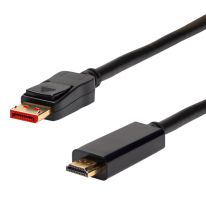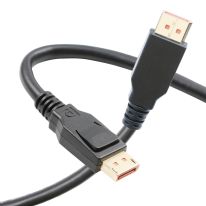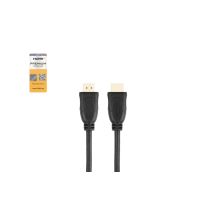Video Cables
17 Results
-
SaleSKU: 022.002.0341 1.5m DisplayPort Male to HDMI® Male Cable | Supports 4K @60Hz as specified in HDMI 2.0Special Price $29.24 $25.43 Regular Price $32.50 $28.26
In stock
-
SaleSKU: 022.002.0343 3m DisplayPort Male to HDMI® Male Cable | Supports 4K @60Hz as specified in HDMI 2.0Special Price $35.56 $30.92 Regular Price $39.50 $34.35
In stock
-
SaleSKU: 022.002.0342 2m DisplayPort Male to HDMI® Male Cable | Supports 4K @60Hz as specified in HDMI 2.0Special Price $31.05 $27.00 Regular Price $34.50 $30.00
In stock
-
SaleSKU: 022.002.0340 1m DisplayPort Male to HDMI® Male Cable | Supports 4K @60Hz as specified in HDMI 2.0Special Price $27.45 $23.87 Regular Price $30.50 $26.52
In stock
-
SaleSKU: 005.008.0071 HDMI® Up Right Angled 90 Degree Adaptor | Supports 1080p@60Hz as specified in HDMI 1.4Special Price $5.38 $4.68 Regular Price $5.98 $5.20
In stock
-
-
SaleSpecial Price $300.15 $261.00 Regular Price $333.50 $290.00
In stock
-
SaleSKU: 022.002.0235 5m DisplayPort v1.4 Cable Male to Male | 8K @60Hz BlackSpecial Price $31.95 $27.78 Regular Price $35.50 $30.87
In stock
-
SaleSKU: 022.002.0234 3m DisplayPort v1.4 Cable Male to Male | 8K @60Hz BlackSpecial Price $28.75 $25.00 Regular Price $31.95 $27.78
In stock
-
SaleSKU: 022.002.0233 2m DisplayPort v1.4 Cable Male to Male | 8K @60Hz BlackSpecial Price $20.65 $17.96 Regular Price $22.95 $19.96
In stock
-
SaleSKU: 022.002.0232 1.5m DisplayPort v1.4 Cable Male to Male | 8K @60Hz BlackSpecial Price $20.44 $17.77 Regular Price $22.70 $19.74
In stock
-
SaleSKU: 022.002.0231 1m DisplayPort v1.4 Cable Male to Male | 8K @60Hz BlackSpecial Price $20.25 $17.61 Regular Price $22.51 $19.57
In stock
-
SaleSKU: 022.009.2010 10m Premium High Speed HDMI® cable with Ethernet | Supports 4K@60Hz as specified in HDMI 2.0Special Price $42.26 $36.75 Regular Price $46.95 $40.83
In stock
-
SaleSKU: 022.009.2005 5m Premium Certified High Speed HDMI® Cable with Ethernet | Supports 4K@60Hz as specified in HDMI 2.0Special Price $19.12 $16.63 Regular Price $21.25 $18.48
In stock
-
SaleSKU: 022.009.2003 3m Premium Certified High Speed HDMI® Cable with Ethernet | Supports 4K@60Hz as specified in HDMI 2.0Special Price $11.65 $10.13 Regular Price $12.95 $11.26
In stock
-
SaleSKU: 022.009.2002 2m Premium Certified High Speed HDMI® Cable with Ethernet | Supports 4K@60Hz as specified in HDMI 2.0Special Price $20.65 $17.96 Regular Price $22.95 $19.96
In stock
-
SaleSKU: 022.009.2001 1m Premium Certified High Speed HDMI® Cable with Ethernet | Supports 4K@60Hz as specified in HDMI 2.0Special Price $7.15 $6.22 Regular Price $7.95 $6.91
In stock




















